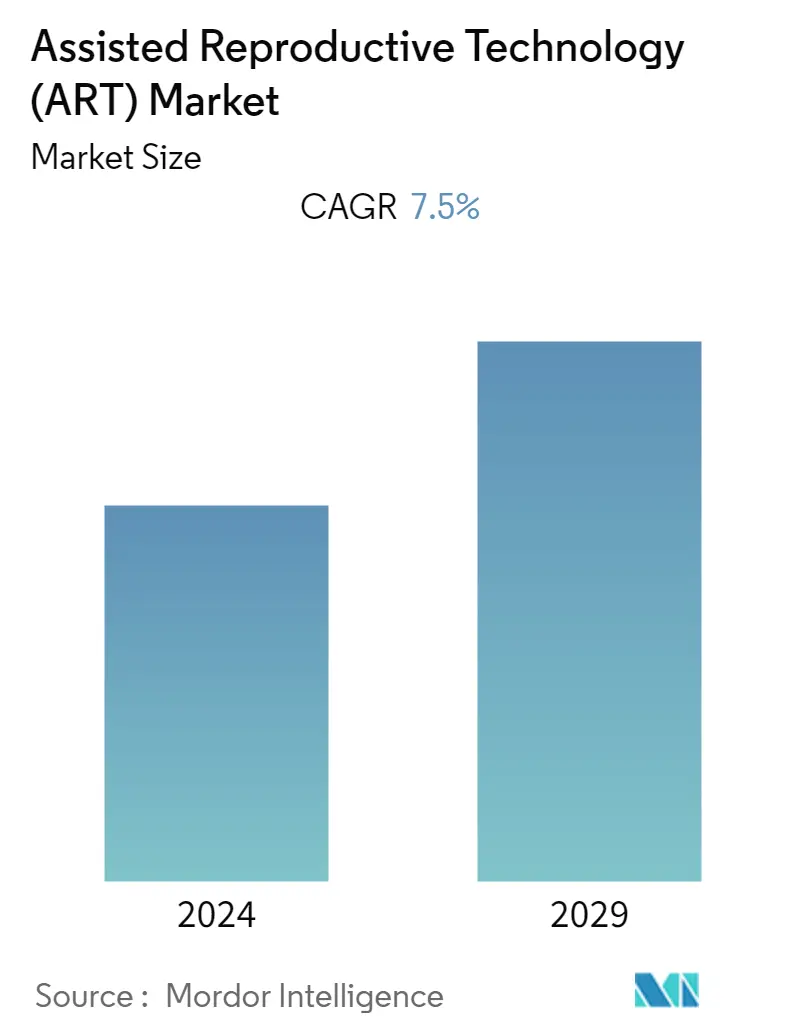Market Size of Assisted Reproductive Technology (ART) Industry

| Study Period | 2019 - 2029 |
| Base Year For Estimation | 2023 |
| Forecast Data Period | 2024 - 2029 |
| CAGR (2024 - 2029) | 7.50 % |
| Fastest Growing Market | Asia Pacific |
| Largest Market | North America |
Major Players_Market.webp)
*Disclaimer: Major Players sorted in no particular order |
Need a report that reflects how COVID-19 has impacted this market and its growth?
Assisted Reproductive Technology (ART) Market Analysis
The Assisted Reproductive Technology Market is expected to register a CAGR of 7.5% during the forecast period(2024-2029).
The global assisted reproductive technology (ART) market size is expected to register a CAGR of 7.5% during the forecast period.
- The increased social and economic burden caused by the novel COVID-19 gradually became worrisome for the healthcare sector. Various research found that the novel coronavirus invades the target cell by binding to angiotensin-converting enzyme 2 (ACE2), which is widely expressed in the ovaries, uterus, vagina, and placenta. In addition, research studies have been published on the impact of the pandemic on the fertility rate.
- For instance, a research study published in the BMJ Open Journal in February 2021 stated that SARS-CoV-2 interrupts female fertility by regulating ACE2 and interfering with ART procedures. Hence, fertility treatments increased during the pandemic and affected the market growth considerably. With the declining COVID-19 cases and large-scale vaccination, the studied market is expected to regain its full potential over the forecast period.
- Factors such as rising cases of infertility due to late marriages, stressful lifestyles, obesity, high junk food intake, smoking, alcoholism, and drug addiction are driving the adoption of ART.
- For instance, according to the data published on female infertility in the National Library of Medicines in December 2022, globally, 11% of women who had a previous live birth were unable to have another, and 2% of women aged 20 to 44 were unable to have any live births at all. As per the above source, infertility rates are higher in Eastern Europe, North Africa, and the Middle East. Hence, owing to the higher infertility, the demand for ART techniques is expected to increase over the years and drive the growth of the market.
- Further, the declining birth rate in different regions across the world and the rapid increase in the geriatric population are expected to have a significant impact on the ART market. For instance, according to the data update by Eurostat in April 2022, the crude birth rate (the number of live births per 1,000 persons) in the European Union is declining gradually, reaching 9.1 in recent years. Hence, the demand for ART technology is expected to grow over the forecast period, fueling the overall market growth.
- In addition, the increasing number of single parents and awareness about same-sex marriages and assisted reproductive technologies are also expected to play a significant role in the growth of the ART market over the forecast period. For instance, according to the 2022 update of the Human Rights Campaign (HRC) Foundation, the number of countries where same-sex marriage is legal has increased to 32 in 2022, and parliamentary or court proceedings are underway in several countries, and this number is further expected to increase. Thus, with the increase in same-sex marriages, the demand for ART techniques is expected to increase significantly, which will boost growth in the studied market.
- However, changing government regulations along with socio-ethical issues and high costs associated with ART are expected to restrain the growth of the assisted reproductive technologies (ART) market is expected to grow during the forecast period.
